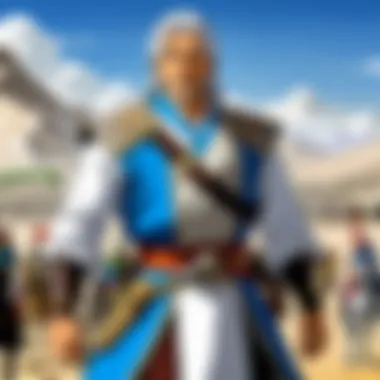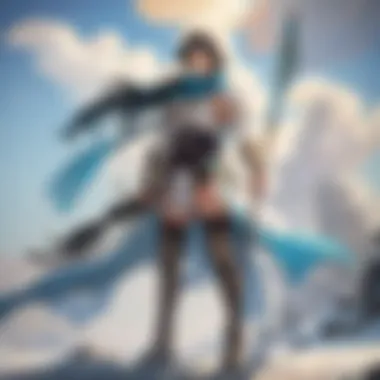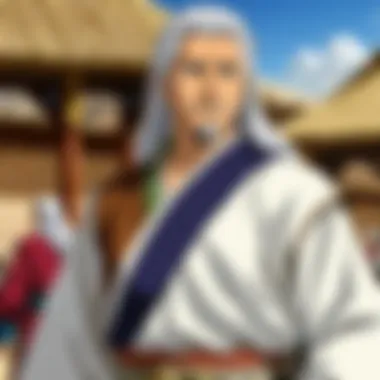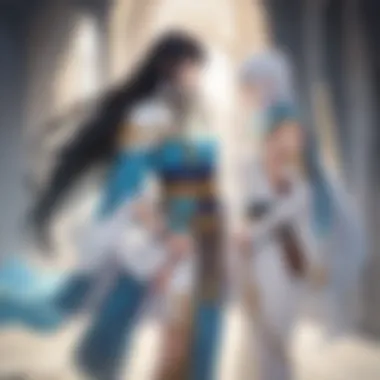The Legend of Arslan: An In-Depth Analysis of an Epic Tale


Intro
The world of anime and manga is vast, filled with narratives that capture the imagination and intellect. Among these, The Legend of Arslan stands out for its rich storytelling and complex characters. This article presents a thorough analysis of the series, delving into its themes, characters, and artistic contributions.
Series Overview
Synopsis and Premise
The Legend of Arslan follows the journey of Arslan, the young prince of the fictional kingdom of Pars. When his kingdom comes under siege by the ruthless forces of the Tuskans, Arslan is thrust into a world of political intrigue and warfare that tests his resolve. The narrative explores Arslan’s evolution from a sheltered youth to a strategic leader, navigating the complexities of loyalty, betrayal, and power.
Notable Characters
The depth of The Legend of Arslan is greatly enhanced by its array of notable characters:
- Arslan: The protagonist, embodying the struggles of a prince tasked with reclaiming his kingdom.
- Daryun: A loyal knight and Arslan’s guardian, representing valor and justice.
- Narsus: A cunning strategist and artist, whose intelligence shapes the outcomes of battles.
- Gieve: A charming bard, bringing a mix of humor and wisdom to the group.
- Silvermask: The enigmatic antagonist, whose motives are tied to Arslan’s destiny.
These characters interact in ways that build a rich tapestry of relationships, presenting various perspectives on honor, loyalty, and justice.
Themes and Motifs
Major Themes Explored
Several themes underpin the narrative of The Legend of Arslan:
- Identity and Growth: Arslan’s journey highlights personal evolution against the backdrop of his responsibilities as a leader.
- Morality of War: The series examines the ethical complexities of warfare, with characters frequently questioning the righteousness of their actions.
- Loyalty vs. Betrayal: The dynamics between characters show how loyalty can be both a strength and vulnerability.
Symbolism in Storytelling
Symbolism plays a crucial role in reinforcing themes. For instance:
- The sword signifies Arslan’s duty and the weight of his lineage.
- The castle’s fall symbolizes the fragility of power and the impermanence of glory.
These elements add layers of meaning, encouraging deeper contemplation on the nature of leadership and sacrifice.
Artistic Style and Animation
Visual Aesthetics and Design
Visually, The Legend of Arslan employs a distinct style that reflects its epic scope. The character designs are detailed yet functional, enhancing the narrative's maturity. The backgrounds are lush and richly colored, transporting viewers to the ancient world.
Animation Techniques and Trends
The animation techniques used in the series contribute to its impactful storytelling. Techniques include:
- Fluid Motion: Action scenes are orchestrated with precision, conveying the intensity of battles.
- Cinematic Framing: The use of different angles and perspectives enhances dramatic moments.
These artistic choices elevate the narrative, ensuring that the visual storytelling complements the rich themes.
The Legend of Arslan not only entertains but also provokes thought about the values we uphold in society.
Preface to The Legend of Arslan
The Legend of Arslan holds a significant place within the realm of anime and manga, captivating audiences since its inception. This article aims to explore various dimensions of the series, thus enhancing the understanding of its complex narrative structure, character development, and thematic depth. Analyzing the introductions to the characters and the world they inhabit reveals how the series interweaves historical context with personal struggles. Understanding these elements is beneficial not only for enthusiasts of the genre but also for those interested in narrative techniques and character arcs.


Origins and Creation
The Legend of Arslan originated from the pen of renowned author Yoshiki Tanaka. First published as a novel series in 1986, it captures the hearts of readers through its blend of fantasy themes with elements drawn from historical events and figures. The narrative is significantly influenced by the Persian epic, which is evident in the names, cultures, and overall thematic concerns. The original novels set the framework for the characters, revealing their complexities and moral dilemmas. This foundational aspect created a strong hook for audiences and helped establish The Legend of Arslan as a respected piece of literature.
Subsequently, adaptations into manga and anime have expanded its reach, introducing new fans to the saga. The adaptations retain much of the narrative's essence while providing visual storytelling that enhances character emotions and plot developments. These adaptations play a crucial role in the ongoing legacy of Arslan. The ability to engage viewers through both written and animated forms allows the story to resonate across diverse platforms, ensuring its influence in contemporary media.
Adaptations in Anime and Manga
The transition of The Legend of Arslan from novels to visual media marks a key point in its evolution. The first anime adaptation aired in 2015, directed by Yoshiki Kawajiri. It faithfully represents the story while introducing vibrant animated sequences that breathe life into the characters. The series captures the essence of Arslan's character with poignant scenes that emphasize his growth as a leader. Additionally, the anime adapts the rich visual style from the manga, initially illustrated by Hiromu Arakawa, which translates the narrative into striking visuals.
The manga adaptation has played a fundamental role in keeping the narrative alive and dynamic. It brings together Tanaka's storytelling with Arakawa's detailed art, maintaining the captivating charm of the source material. This collaboration demonstrates that the main themes remain intact while reaching wider audiences through distinct mediums.
These adaptations reveal a variety of choices in character portrayal and world-building techniques. They show how diverse interpretations can yield fresh insights into well-known tales, ensuring that The Legend of Arslan continues to thrive in popular culture. As a result, both new and returning fans always have an opportunity to explore the depths of Arslan's journey in different formats.
Narrative Structure and Themes
In analyzing The Legend of Arslan, the narrative structure and its themes are central to understanding its enduring appeal. This section will explore how the narrative framework supports character development and thematic depth, enhancing the story's impact on its audience. The interplay of story arcs, motifs, and character journeys contributes significantly to the series' complexity and richness.
Hero's Journey Framework
The Legend of Arslan is profoundly rooted in the archetypal hero's journey, a narrative template that literary theorist Joseph Campbell popularized. This structure is especially relevant as it reflects Arslan's transformation from a sheltered prince to a capable leader. Throughout the series, Arslan faces various trials that challenge his ideals and skills. The stages of the hero’s journey unfold as follows:
- Call to Adventure: Arslan's life changes when he witnesses his kingdom being invaded. This initial disruption propels him into a world filled with conflict and moral complexities.
- Mentorship: Characters like Narsus provide guidance, shaping Arslan's decisions. This positioning emphasizes the importance of mentorship in personal growth and leadership.
- Trials: Arslan encounters various obstacles, from military challenges to personal betrayals. Each trial reveals his character and pushes him towards growth.
- Transformation: By the end of the narrative, Arslan is no longer just a prince but a leader who understands the weight of responsibility. His journey symbolizes the transition from innocence to wisdom, a theme that resonates universally.
This framework not only charts Arslan's physical journey but also his evolution on multiple emotional and moral fronts. It highlights the significant theme of identity and growth, rendering the narrative relatable to the audience.
Power and Its Consequences
Another critical theme in The Legend of Arslan is the examination of power and its ramifications. The series presents power as a double-edged sword, essential for achieving goals yet fraught with peril.
- The Nature of Power: Characters such as King Andragoras and the antagonistic Lusitanian forces mirror the different approaches to power. The narrative reveals that while some pursue power for noble reasons, others exploit it for selfish gain.
- Consequences of Leadership: The weight of leadership becomes evident as characters face the repercussions of their choices. Arslan, in particular, learns that the path to power is layered with sacrifices and moral dilemmas. His struggles compel viewers to consider the ethical dimensions of authority.
- Conflict and Resolution: The series showcases war not just as a backdrop but as a catalyst for change. The ramifications of warfare extend beyond physical destruction, highlighting the emotional and psychological toll on both leaders and their followers.
"The manner in which power is wielded can dictate the fate of nations, shaping the legacies of those who lead them."
Analyzing these elements reveals not just a story of conquest but a thoughtful exploration of what it means to hold power in responsibility. Arslan's journey becomes a larger commentary on the nature of leadership and the moral choices that shape human history.
Character Analysis
Understanding the characters in The Legend of Arslan is crucial for grasping the depth of the story. Characters bring life to the tale and embody its themes. Through their struggles, development, and relationships, the audience can connect with the narrative on a personal level. This analysis of character dynamics provides insight into how they reflect broader themes of power, loyalty, and identity.
Arslan: The Reluctant Hero
Arslan represents the archetype of the reluctant hero. His journey begins with vulnerability, as he is a young prince who feels unprepared for the burdens of leadership. This aspect is critical because it allows the audience to empathize with his fears and uncertainties.
Arslan's characterization highlights growth. Throughout the narrative, he evolves from an unsure boy into a competent leader. This transformation is shaped not only by his experiences but also by the influences of those around him. More than just a warrior, Arslan learns to navigate the complex realms of trust and betrayal, impacting his ability to unite his supporters.
Supporting Characters and Their Roles
The supporting characters are integral to Arslan's journey. They each embody elements that complement or contrast with Arslan's development. Let us explore three significant characters:
Darun: The Loyal Shield
Darun serves as Arslan's steadfast protector. His loyalty is unwavering, demonstrating a key characteristic of devotion. This makes Darun a beneficial choice for the narrative because he embodies the concept of loyalty in the face of adversity. His presence provides stability to Arslan's tumultuous journey.
Darun's unique feature is his combat prowess. He does not just defend; he actively engages in battles, showcasing his strategic prowess. However, this dependence on Darun's physical strength may limit the portrayal of other tactical elements in the storyline, a noteworthy consideration in the character dynamics.


Narsus: The Strategic Mind
Narsus is characterized by his intelligence and strategic thinking. He serves a pivotal role in guiding Arslan through political machinations. His insight into human nature and conflict makes him a valuable ally. Narsus’s ability to devise intricate plans enhances the depth of the plot.
The unique feature of Narsus lies in his ability to manipulate situations through intellect rather than brute force. This presents the advantage of showcasing the importance of brains over brawn in leadership. However, his overly cautious approach sometimes creates tension with more impulsive characters, which adds complexity to the narrative.
Elam: The Resourceful Companion
Elam complements Arslan’s journey with his resourcefulness. His practicality and quick-thinking in difficult situations provide necessary support for Arslan and their companions. Elam symbolizes adaptability, contributing to problem-solving throughout the series.
A key characteristic of Elam is his background and skills in espionage. This aspect is beneficial as it introduces elements of stealth and strategy in the narrative. Nonetheless, relying on Elam’s stealth can raise questions about trust and transparency within the group, adding an additional layer of conflict.
The strength of The Legend of Arslan lies not just in its central hero, but in how supporting characters enrich the thematic fabric of the story.
Understanding these characters helps underscore central themes such as loyalty, strategy, and resourcefulness. This in-depth character analysis contributes significantly to appreciating the layers within The Legend of Arslan, providing a more profound engagement with the narrative.
World-Building Techniques
World-building serves as the backbone for any narrative, especially in epic tales like The Legend of Arslan. It creates immersive settings where characters evolve and stories unfold. This specific world is enriched by historical accuracy and cultural nuances. Understanding the world-building techniques used in this narrative helps to appreciate the depth of the story.
Historical Inspirations and Settings
The world of The Legend of Arslan draws heavily from historical events and figures, particularly those related to Persian history. The kingdom of Pars closely resembles the ancient Persian Empire in several ways. This connection is not merely superficial; it impacts the narrative significantly. By weaving real history into fiction, the creators lend authenticity to the characters and conflicts.
The depiction of royal courts, military tactics, and societal hierarchies reflects a seasoned understanding of how ancient civilizations functioned. Such historical inspirations also serve as a vehicle for exploring power dynamics, morality, and governance. It stimulates intellectual engagement by posing questions about loyalty, duty, and identity that transcend time.
Cultural Influences in Storytelling
Beyond mere historical reference, The Legend of Arslan incorporates various cultural elements to enhance its narrative depth. For instance, it encapsulates aspects of Middle Eastern lore, folklore, and ethical precepts. The complexity of these cultural influences cannot be overstated. They enrich the characters and plots, making them relatable and managing to resonate with a global audience.
The use of traditional motifs, such as honor, betrayal, and redemption, situates the story in a broader cultural context. These themes allow viewers to reflect on their own societies and moral choices, creating a dialogue between the past and present. The fluidity with which it intertwines different cultures offers an expansive view of humanity's shared experiences.
In summary, the world-building techniques in The Legend of Arslan are intricate and carefully crafted. They not only establish the setting but also provoke thoughts about historical and cultural dimensions, breathing life into the legend and ensuring its lasting impact on audiences.
Artistic Elements in The Legend of Arslan
Artistic elements in The Legend of Arslan serve as the backbone of its storytelling. They not only enhance the visual experience but also contribute significantly to character development and thematic expressions. The show employs a unique combination of art style and animation techniques that cultivates an immersive world. These elements are especially crucial in conveying the narrative's complex layers, making it accessible and engaging.
Visual Style and Character Design
The visual style is where The Legend of Arslan shines. Its design choices reflect a deep understanding of historical contexts, with influences drawn from Persian literature and ancient cultures. The intricate details in character design are notable, where each character's attire symbolizes their social status and personality traits. For instance, Arslan's simple yet regal clothing contrasts sharply with the elaborate armory of his enemies. This visual distinction does more than serve aesthetic purposes; it communicates their motivations and alliances immediately to the audience.
The characters are rendered with an emphasis on expression and movement. Subtle changes in their facial features and body language effectively convey their thoughts and emotions. This dynamic portrayal invites viewers to empathize more with their struggles. Moreover, supporting characters like Narsus and Darun are designed to mirror their strategic and loyal qualities, respectively. The visual style, therefore, acts as a tool for deeper storytelling, reinforcing character dynamics throughout the series.
Impact of Animation on Narrative Delivery
Animation plays a critical role in how The Legend of Arslan delivers its narrative. The choice of animation techniques adds layers to the story's depiction of battles and emotional conflicts. Fast-paced sequences, combined with fluid animation, heighten the tension during pivotal battle scenes. In contrast, slower animations during moments of introspection allow viewers to digest the weight of the characters' decisions.
Additionally, the series employs color grading effectively; darker tones are used to signify despair or betrayal, while brighter colors often accompany moments of hope or triumph. This color scheme guides the audience's emotional response, enhancing the narrative without relying on dialogue.
"Animation in a narrative context is not merely a style but becomes an intrinsic component of storytelling, influencing how themes resonate with viewers."
In essence, the artistic elements of The Legend of Arslan are integral to its overall narrative. They enhance not only the aesthetic appeal but also the emotional depth and thematic cohesion of the story. Each visual and animated choice resonates with the audience, creating a more profound experience that captures the richness of its epic tale.
Critical Reception and Impact


The critical reception and impact of The Legend of Arslan are essential aspects of understanding its significance in the anime and manga landscape. This section delves into how audiences have embraced the series over time and its influence on the genre as a whole. The narrative's engaging themes, character development, and world-building contribute to its status as a landmark within Japanese media, fostering discussions among fans and scholars alike.
Audience Reception Over Time
Over the years, The Legend of Arslan has attracted a wide array of viewers and readers, reflecting its rich storytelling and complex characters. Upon its initial release, the anime and manga garnered varied reactions, but both quickly developed a dedicated fanbase. As audiences became more familiar with the intricate plots and political undertones, their appreciation deepened. Viewers began to recognize the subtext of power struggles and the moral dilemmas faced by Arslan, leading to thoughtful discussions in online forums.
Feedback from fans often highlights the relatability of Arslan’s struggles and his journey toward becoming a leader. This relatability resonates with many. Review platforms and social media discussions illustrate how fans connect with individual character arcs, particularly those of Arslan and his companions, such as Narsus and Elam. The emotional resonance of their stories sustains ongoing interest in the series, proving its relevance through changing times.
Influence on Other Works in the Genre
The Legend of Arslan stands as a notable catalyst in the evolution of anime and manga narratives. Its themes of honor, duty, and betrayal find echoes in subsequent works, influencing storytelling techniques. Other creators have drawn inspiration from Arslan's layered character development and narrative complexity, enhancing the genre's offerings.
Several series that follow Arslan's model exhibit deeper explorations of character motivations and moral ambiguity. Works like Attack on Titan and Vinland Saga bear similarities in their thematic focus on conflict and the quest for identity. The narrative style of The Legend of Arslan has arguably paved the way for richer, more immersive storylines in these newer adaptations.
Thematic Reflections in Modern Context
In today's world, the relevance of themes explored in The Legend of Arslan continues to resonate deeply. The story engages with concepts of leadership, morality, and the turmoil of birthright versus personal identity. By addressing issues such as duty and honor, the series prompts viewers to examine their own values and the motives behind their choices. In a time when political and social challenges mirror those in Arslan's world, the narrative encourages discussions about power dynamics and the complexities of governance.
Relevance of Arslan's Themes Today
The themes presented in The Legend of Arslan provide a rich foundation for reflection. For instance, the juxtaposition of noble intentions against harsh realities serves as an apt commentary on modern leadership. Leaders often grapple with the morality of their decisions, paralleling Arslan's growth from a sheltered prince to a compassionate ruler.
Moreover, The Legend of Arslan successfully tackles the identity crisis that comes with expectations. Many individuals today feel the weight of societal and familial expectations, echoing Arslan's struggle against his destiny.
- Identity vs. Expectation: The conflict between personal desire and obligation illustrates a well-known dilemma in contemporary life.
- The Burden of Leadership: Arslan’s evolution reflects how leaders must manage their own character while addressing the needs of others.
"The legend serves not just as mere fantasy but a reflection of our actions and choices in life."
Lessons from Arslan's Journey
Arslan's journey conveys significant lessons pertinent to current audiences. The narrative is grounded in the idea of resilience in the face of adversity. Arslan faces numerous obstacles, yet he remains steadfast. This is a powerful reminder for anyone navigating life's challenges, encouraging a mindset of perseverance.
Furthermore, the story emphasizes the importance of alliances and trust. Throughout the series, relationships shape Arslan's journey and success. Cooperation becomes essential, mirroring today's need for collaboration in various societal fronts.
- Value of Trust: Building and maintaining trust leads to stronger alliances, both personally and professionally.
- Adaptability: Arslan learns to adapt in situations, which is critical in an ever-changing world.
Culmination: The Enduring Legacy of Arslan
The importance of the Conclusion: The Enduring Legacy of Arslan section in this article cannot be understated. This segment provides a synthesis of the key themes and characterisations explored throughout the analysis while examining the lasting implications of these elements in the contemporary landscape of anime and manga. Here, we will encapsulate how The Legend of Arslan resonates within its genre and society at large. It reiterates the relevance of its narrative, emphasizing the profound journey of its protagonist, Arslan, and his allies. Moreover, it serves to highlight the value of the lessons derived from their struggles and triumphs.
Essential themes include the examination of power dynamics and the moral complexities involved in leadership and war. Such themes encourage reflective thought on the impact of governance and loyalty, crucial elements for understanding both historical and modern contexts. The characters, particularly Arslan, serve as embodiments of these themes, making their arcs vital to grasping the narrative.
Summation of Themes and Characters
In summarizing the themes and characters within The Legend of Arslan, it becomes clear how meticulously crafted they are within the overarching narrative structure. The duality of power, as depicted through Arslan's initial naivety juxtaposed against his growth into a capable leader, reflects broader social issues. Supporting characters, such as Narsus and Darun, add layers of complexity, showcasing diverse perspectives on ambition, loyalty, and sacrifice. Their relationships deepen the narrative, providing further understanding of Arslan's journey.
- Themes:
- Key Characters:
- The intricacies of governance
- The burden of leadership
- Friendship forged through adversity
- The consequences of betrayal
- Arslan: The reluctant hero who grows into his role.
- Narsus: A strategist embodying intellect and pragmatism.
- Darun: The embodiment of loyalty and courage, supporting Arslan steadfastly.
- Elam: A resourceful ally who adds both humour and depth to the ensemble.
Altogether, these elements not only define The Legend of Arslan but also engage audiences in contemplating the intricacies of human nature and societal structures.
Future Prospects in Adaptations
When considering future prospects in adaptations, The Legend of Arslan has substantial potential. Given the rich lore and diverse character arcs, adaptations can explore various media forms. Live-action adaptations, further anime seasons, and expanded manga narratives all offer fertile ground for revisiting the story. Potential developments could delve deeper into the backstories of secondary characters or explore untold events within the timeline.
The rising popularity of anime globally indicates a readiness for new narratives, particularly those rooted in rich historical context. As such, adaptations could more closely examine Arslan’s world, exploring the socio-political dynamics in greater detail. Moreover, thematic adaptations could further tackle contemporary issues, like the ethical implications of leadership and loyalty in modern governance, making The Legend of Arslan relevant for new audiences.
The enduring legacy of Arslan lies not just in its epic narrative but in the capacity for continuous reinterpretation and exploration in various formats.



